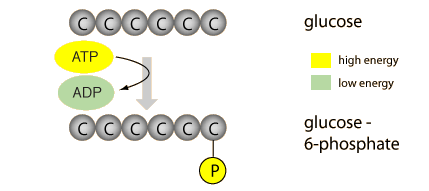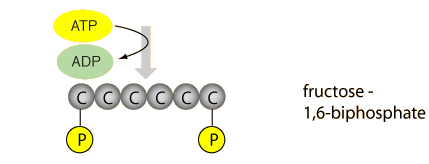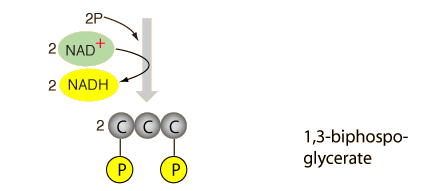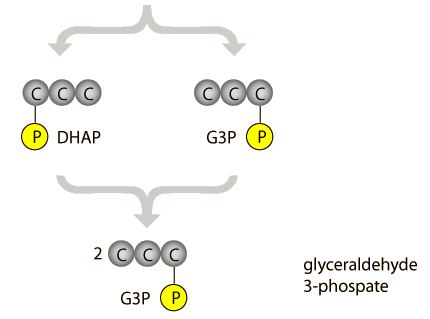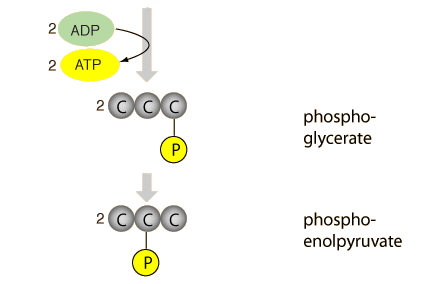Steps of Glycolysis
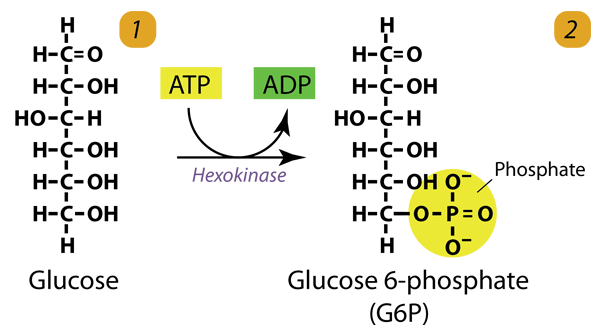
Glycolysis is a series of reactions which starts with glucose and has the molecule pyruvate as its final product. Pyruvate can then continue the energy production chain by proceeding to the TCA cycle, which produces products used in the electron transport chain to finally produce the energy molecule ATP. The first step in glycolysis is the conversion of glucose to glucose 6-phosphate (G6P) by adding a phosphate, a process which requires one ATP molecule for energy and the action of the enzyme hexokinase. Each step of glycolysis operates with the aid of an enzyme, which greatly speeds up the reactions to allow the process to proceed fast enough for metabolic needs. Ahearn comments that enzymes allow reactions to run at the "speed of life".
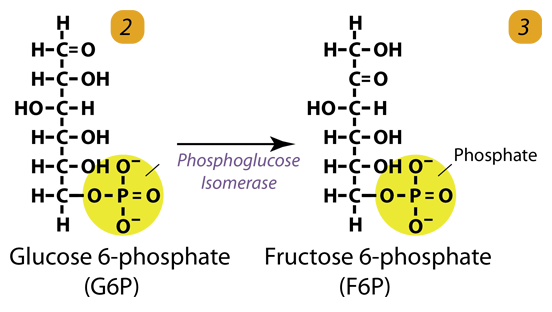
This step involves a simple rearrangement of G6P to produce Fructose 6-phosphate (F6P). It forms the substrate for the next step which is crucial control point.
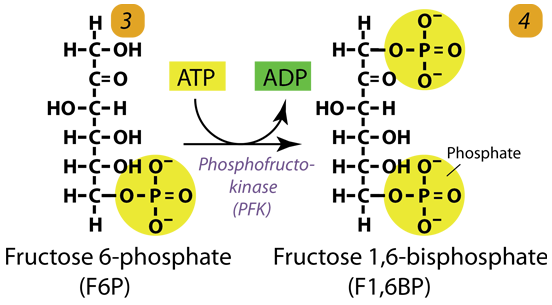
In this step a second ATP is required to add a second phosphate to F6P. This forms Fructose 1,6-biphosphate (F1,6BP). The enzyme involved is Phosphofructokinase (PFK). This enzyme is capable of controlling the entire pathway as seen below. To this point, the process involves rearrangement with the investment of two ATP. This energy is used to add two phosphates, and marks the end of the energy investment phase.
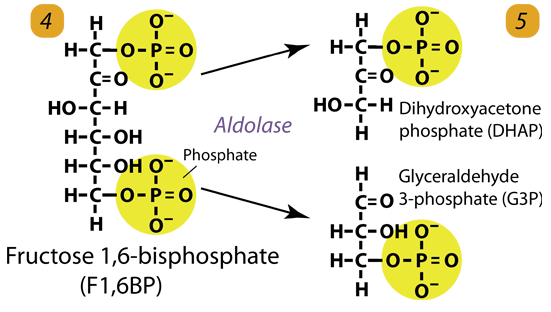
Catalyzed by the enzyme aldolase, the F1,6BP is split into two three-carbon molecules, Dihydroxyacetone phosphate (DHAP) and Glyceraldehyde 3-phosphate (G3P). These two molecules are isomers, and each can be easily rearranged into the other.
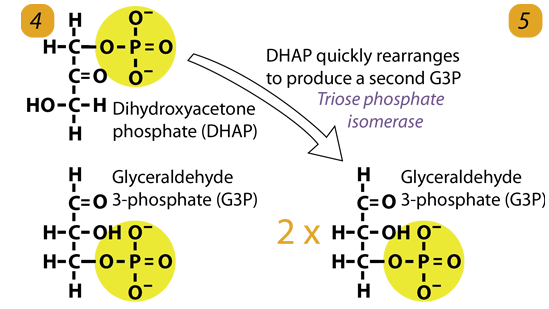
Catalyzed by Triose phosphate isomerase, the DHAP is quickly rearranged to produce a second G3P. The process to this point has converted one 6-carbon molecule of glucose into two 3-carbon G3P molecules.
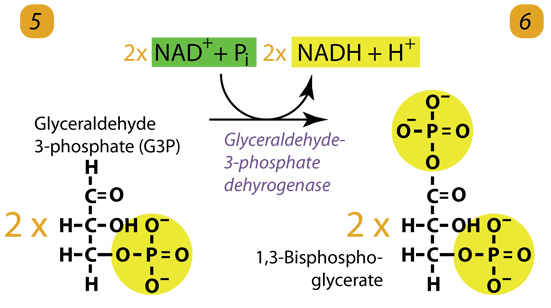
Starting at this step, glycolysis becomes a process of energy generation where ATP is made. At the beginning of this process, the G3P is converted to 1,3-bisphosphoglycerate. This involves the addition of another phosphate. In this process the adehyde molecule is converted into an acid.This process of conversion of the aldehyde to an acid is an oxidation. In the process the molecule being oxidized loses two electrons, and it gives those two electrons to NAD+ which accepts them plus a proton to produce NADH. We had two G3P molecules, so we we get two molecules of 1,3 bisphosphoglycerate, and gain two NADHs out of this reaction. These will be used in the electron transport chain to provide a much bigger energy payoff. The acid group created by the oxidation reaction gives a phosphate to 1,3 bisphosphoglycerate. This phosphate addition is different from the ones seen so far which required ATP energy. This phosphate is not from ATP, but is a free phosphate added onto the acid. The energy for doing this comes from the oxidation of the same step. That's why we don't need ATP energy to add the phosphate. The net output from this step is two 1,3 bisphosphoglycerates and two NADHs.
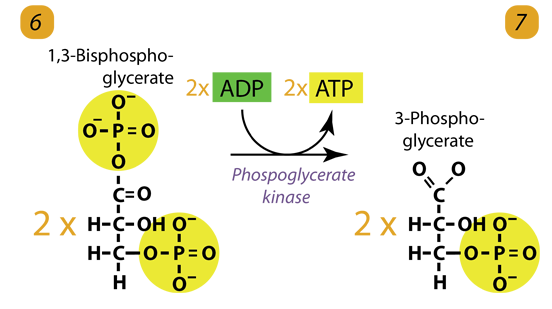
This step begins the part of glycolysis where ATP is made. First, a phosphate is transferred away from each of the two 1,3 Bisphosphoglycerates to add to ADP and make ATP. This leaves behind two molecules of 3-Phosphoglycerate.
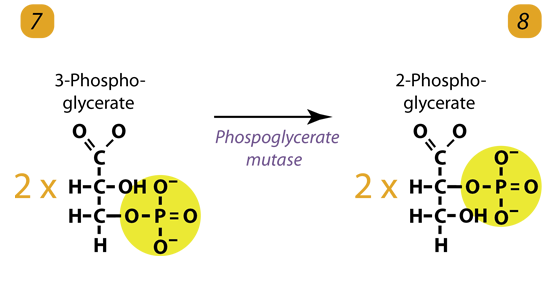
The two molecules of 3-Phosphoglycerate undergo rearrangement to produce 2-Phosphoglycerate.
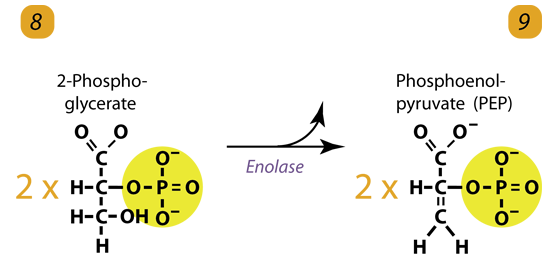
The two 2-Phosphoglycerate molecules with the action of the enolase enzyme form two molecules of phosphoenylpyruvate (PEP). PEP is the substrate for the final step of glycolysis.
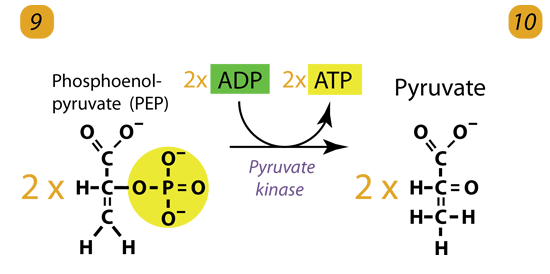
With the aid of the enzyme pyruvate kinase, the final step produces two ATPs and two molecules of pyruvate. There is enough energy left over to almost produce two more ATPs, but since it falls short, this energy is given off as heat.

|
